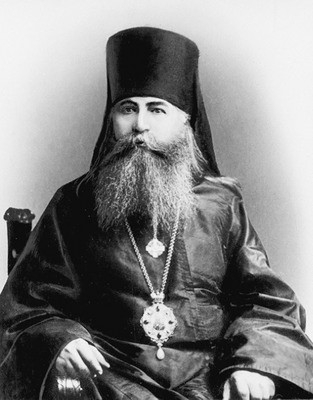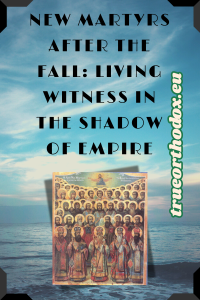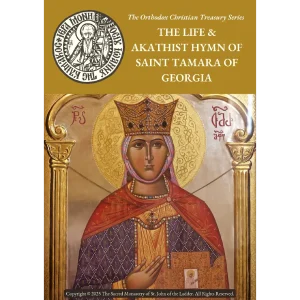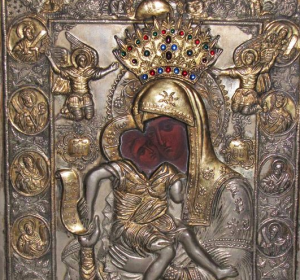Hieromartyr Basil, Archbishop Of Chernigov And Those With Him

Archbishop Basil (Bogoyavlensky) was born on February 1, 1867, into the family of a priest in Tambov diocese. Brought up in strict church piety, Basil was filled from early childhood with love for the Church and his earthly homeland, and for that reason, on attaining adulthood, he never had any hesitation in following in the steps of his father and devoting himself to the service of the Church. In 1888 he finished his studies at Tambov seminary, and in the same year was ordained to the diaconate. Two years later, on March 11, he was ordained to the priesthood and appointed to serve in the church of the village of Ovsyanki, Kirsanvosky uyezd, Tambov province.
The incurable illness of his wife forced Fr. Basil to think of other conditions of service to the Holy Church. In 1896 he entered the Kazan Theological Academy, where he became friendly with the rector, Bishop Anthony (Khrapovitsky). In 1900 Fr. Basil graduated from the academy, and accepted the suggestion of his abba that he stay on to serve as a teacher there.
After the death of his wife, Fr. Basil took the advice of Bishop Anthony and entered the Holy Trinity Alexander Nevsky Lavra, where on August 14, 1908 he was tonsured into monasticism. On October 15 of the same year he was appointed rector of the Chernigov theological seminary with promotion to the rank of archimandrite. On July 26, 1909 (May 12, 1911, according to another source), he was consecrated Bishop of Sumsk, a vicariate of the Kharkov diocese, in St. Petersburg. On March 4, 1911, he was transferred to the see of Novgorod-Seversk, a vicariate of the Chernigov diocese, and on May 12 – to the see of Chernigov and Nezhin.
Bishop Basil’s period of service in Chernigov was marked by the successful completion of many projects: the construction of two large houses for pilgrims coming to venerate the relics of St. Theodosius, and a sanatorium for the students at the seminary; the opening of the second women’s school in the diocese with funds given from the state treasury by Tsar Nicholas; a large increase in the sphere of activity of the Orthodox Brotherhood of St. Michael, Prince of Chernigov; the publication of the journal Faith and Life by the same Brotherhood (in 1912); the creation in Chernigov of a yedinovertsy deanery in whose administration were numbered twelve churches. Vladyka also devoted much attention to charitable work, supporting the existing charitable institutions and organizing the collection of alms for the starving peasants of the eastern provinces during years of bad harvests. On July 6, 1916 he was appointed president of the Publishing Council attached to the Holy Synod. On October 5, 1916, in recognition of his services to the diocese, Vladyka was raised to the rank of Archbishop of Chernigov and Nezhin.
On May 6/19, 1917 he was retired, and was appointed administrator of the Nikolayevsky Terebensky Desert in Tver diocese. From August 11 (or 14), 1917 he was placed in charge of the Moscow Zaikonospassky monastery. In 1917 Vladyka Basil was called to Moscow to participate in the Preconciliar Commission which was preparing for the Council of the Russian Orthodox Church.
When Archbishop Andronicus of Perm was killed by the Bolsheviks in 1918, the Moscow Church Council sent a special commission, headed by Archbishop Basil, who had a high reputation as an administrator, to investigate the circumstances of the murder.
The Soviet government consented to an investigation and even provided a private coach for the use of the commission. (During the early days of the Soviet government, the Church Assembly addressed it several times with requests, declarations and protests). But the activity of the investigating committee in Perm aroused the indignation of the communists, especially those who were guilty of the crime, and they took measures to conceal information from the Moscow Assembly.
After concluding its investigation, the commission was on its way back when a band of Red soldiers broke into the coach, between the towns of Perm and Viatka. On May 6, 1919, according to one account, Archbishop Basil, Archimandrite Matthew, rector of the Perm seminary (who is called a bishop in one account) and a layman, all the members of the commission, were killed, and their bodies thrown out of the moving train into the water from the Kama bridge. They were buried by local peasants, but as their graves began to attract pilgrims, and miracles were recorded, the communists dug up the bodies and burned them. According to another version, Archbishop Basil was arrested and after a short imprisonment was shot together with other members of the commission.
(Sources: Victor Korolev, in Novomucheniki i Ispovedniki Russkoj Pravoslavnoj Tserkvi, Moscow: St. Tikhon’s Theological Institute, 1997 (in press); Russkiye Pravoslavnye Ierarkhi, Paris: YMCA Press, 1986, p. 21; M.E. Gubonin, Akty Svyateishego Patriarkha Tikhona, Moscow: St. Tikhon’s Theological Institute, 1994, p. 965; Ikh Stradaniyami Ochistitsa Rus’, Moscow, 1996, p. 56; Vitaly Shumilo, “Preterpevshij do Kontsa”, Vestnik I.P.Ts. (Odessa), April-June, 1997, N 2 (8), pp. 32-36; “Svyashchennomuchenik Vasilj Chernigovskij”, Pravoslavnaya Zhizn’, 48, N 2 (578), February, 1998, pp. 13-17; Za Khrista Postradavshiye, Moscow: St. Tikhon’s Theological Institute, 1997, pp. 222-223)




